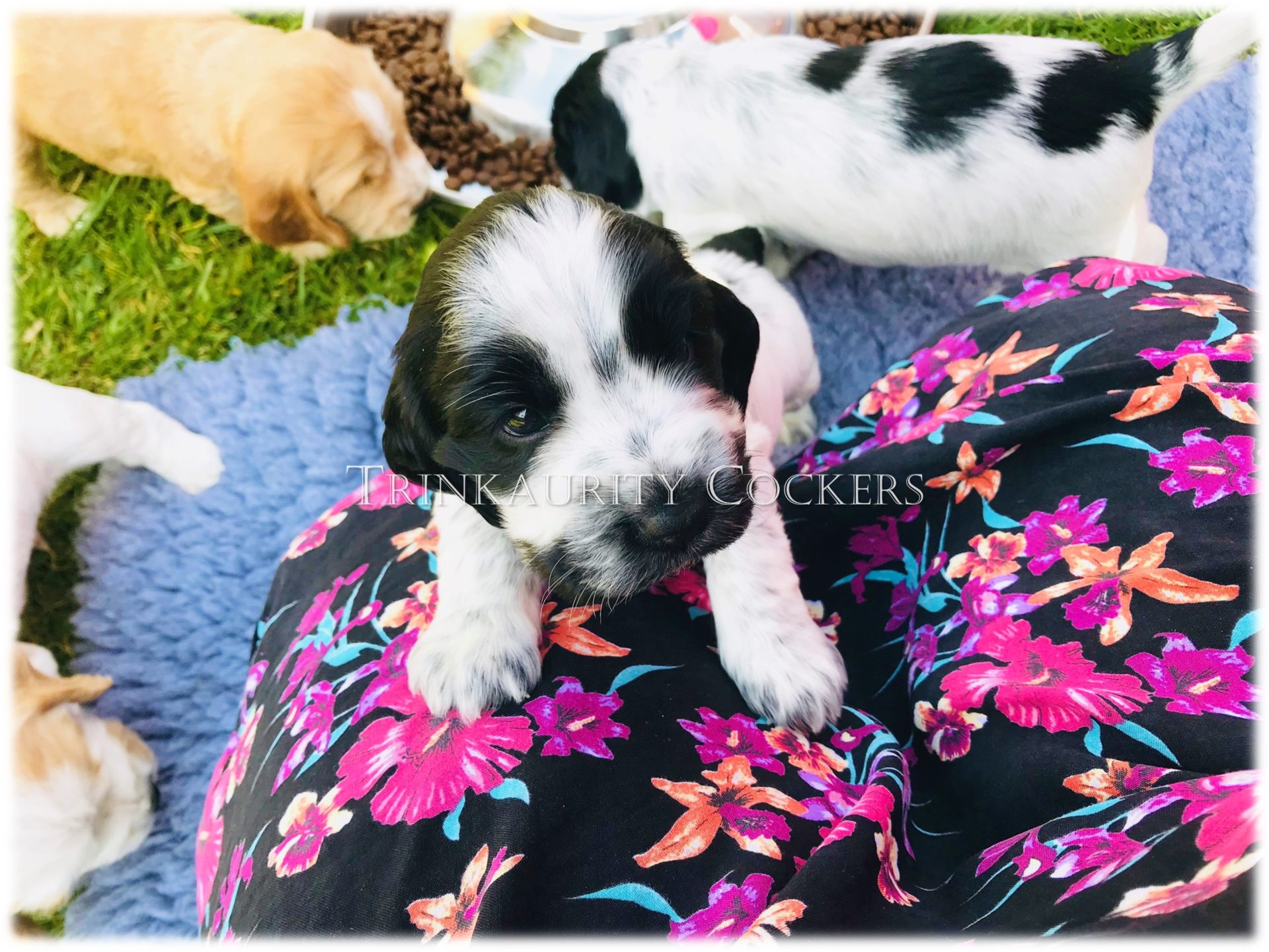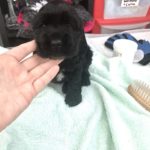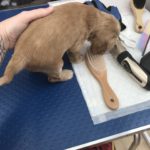The English Cocker Spaniel
The English cocker is a loyal, happy, tail wagging, intelligent and playful pup. They thrive on human companionship and they are happiest when being part of the family. They can make a good watchdog, or in my case… dogbell! Because of their high intellect, an untrained cocker, is a naughty cocker! Training and enrichment is very important to Trinkaurity Cockers and an essential element to my puppy parent selection.
The cocker spaniel is known as the ‘merry cocker’. They originally got their name from ‘‘woodcock’, where the breed would hunt woodcock many moons ago in the early 20th century. There are two strains: worker and show. Show type cockers are an affectionate breed and will always greet you with the merry cocker tail wag, although they wag so very much their entire rear end will sway! They really are a happy breed. Working strain are equally loving, devoted and affectionate, however they are more driven and will require more exercise/focused training.
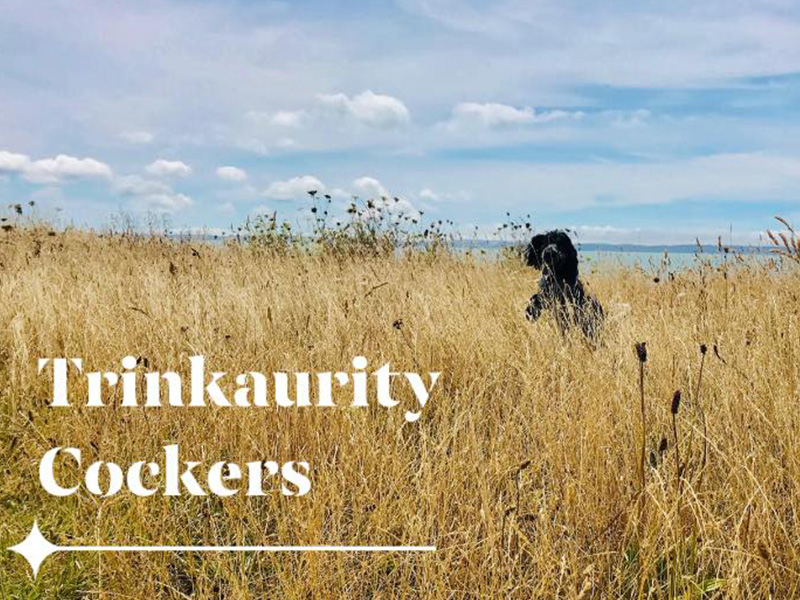
Types of Cocker Spaniels
There are two strains of English Cocker Spaniels, working and show type. It is fairly easy to tell them apart, as show type have lower set ears (eyes set generally in line with their eye socket) and a longer silky coat, with fuller body feathering (if not clipped!). Working type cockers ears are set in line with the top of their head, their shoulders are broader and they have shorter coats with less feathering.
Trinkaurity Cockers only breed show type and will NEVER mix show and working strain.
Show Type Cocker Spaniels
Breed Group: Gundog
How much exercise: Adult approx.. 1 hour daily/ Puppies 5 mins/month of age daily
Coat Length: Medium
Grooming needs: High – requires daily brushing, ears and paws require grooming to keep neat.
Coat shedding : Yes
House Environment: Small or Large house, in a town or country
Minimum garden size: Small or medium
Life span: 10 years+
Coat Colours: The English Cocker Spaniel
At Trinkaurity Cockers, I will always place coat colour after the DNA profile, health test results, BVA eye scores, hip scores, preventative healthcare, nutrition received, temperament, environment raised, trainability of a stud, body score, general health, health of progeny, incidents of illness/conditions in progeny etc…the list goes on! I will always ensure that the stud is raised within a family home and not an outside kennel as I am raising for families, most often with children.
Breed Standard colours
‘Breed standard colour’ is the term used by the Kennel Club as to what coat colour is deemed accepted within the ‘breed standard’. The breed standard coats would be considered ‘traditional’ and well-known.
Breed standard colours for English Cocker Spaniels include:
- Black; Black & Tan; Black & White; Black & White Ticked; Black White & Tan
- Blue Roan; Blue Roan & Tan
- Chocolate; Chocolate & Tan; Chocolate & White; Chocolate Roan; Chocolate Roan & Tan; Chocolate White & Tan
- Golden
- Lemon & White; Lemon Roan
- Liver; Liver & Tan; Liver & White; Liver & White Ticked; Liver Roan; Liver Roan & Tan; Liver White & Tan
- Orange & White; Orange & White Ticked; Orange Roan
- Red
Non-Breed Standard Colours
These would be coat colours that the Kennel Club would deem as not accepted within the breed standard. There are many healthy, well-balanced dogs within the breed of the following coat colours, and the Kennel Club will advise new owners to only select a dog that fits within the breed standards.
The Kennel Club do point out that coat colour is ‘only one consideration when picking a breed or individual dog‘ and ‘health and temperament should always be a priority over colour‘.
Non-breed-standard colours in this breed include:
- (all NBS) Sable; Black Sable; Blue Roan Sable; Chocolate Sable; Chocolate Sable Roan; Dark Sable; Gold Sable; Red Sable; Sable Roan
Grooming Needs of The English Cocker Spaniel
Due to the show type cockers coat, they require daily brushing to maintain good coat and skin health. Knots form very easily, which left for more than a day or two begin to create matts. Matts are the most painful things for our pups. You will need to brush your pup daily, both for good coat and skin health, but to continue to desensitise your puppy to the experience of being groomed.
I would advise parents to place a towel on a higher surface, prepare the tools you are going to use, choose a time when you know your puppy is not full of beans and place them on the raised surface. Do not over excite them during grooming time as you need to encourage them to remain calm. Do not allow them to mouth grooming tools. If you are only getting 10 good seconds of grooming before they start mouthing, groom them for 8 seconds and stop just short of when they become restless to end on a positive. Throw some treats on the ground and allow your puppy to go and find them. Do this every day!
As soon as your puppy has had their final vaccination, book them into regular (every 4 weeks) puppy grooms with a recommended groomer. If you aren’t sure who to go to, have a look on social media and look at reviews of groomers locally and examine their work.
I would contact a groomer when you place your reservation fee down on your puppy as a lot of them have waiting lists.
If you offer your puppy 4 weekly professional puppy grooms up to the age of 18 months, along with your daily coat care, your puppy will be very well habituated to their life-long grooming needs for their breed.
Once your puppy is an adult, you have a choice to hand-strip, scissor cut, clip or a mixture of these in maintaining their coat. Do not clip puppy coats under the age of 12 months unless you wish to have a curly cocker! Be aware that if you choose to clip their coat as a adult, they are unable to protect their skin from the sun.
They are best maintained by regular sessions as an adult with a professional groom every 4-8 weeks (roughly).
Training Considerations: The English Cocker Spaniel
Training
This breed really are so keen to please! English Cocker Spaniels who are raised well, generally love training and are very easy to train. The training begins from their Mama and the Breeder during the first 8 weeks. I take my responsibility very seriously to ensure I will do all I can to provide every opportunity for my Trinkaurity pups to thrive and love to learn. However, I only have them for 8 weeks, thereafter, it is the responsibility of puppy parents to put in training sessions every day and weekly professional training. The more you put in, the more you will get out.
Building the bond through training, most especially in those early days, is very easily achieved. For example: every meal time is an opportunity for you to let your pup work for their food, after all in the wild no magical bowl of perfectly balanced nutrition would appear 4 times per day at 8 weeks of age! Each interaction, builds neurological connections within your pups brain; they learn to learn!
The phrase ‘if you don’t use it, you lose it’ is absolutely right. If you do not take advantage of these very early days and put the work in, you have every possibility of your pup developing unhealthy behavioural habits later in life which can take longer to correct.
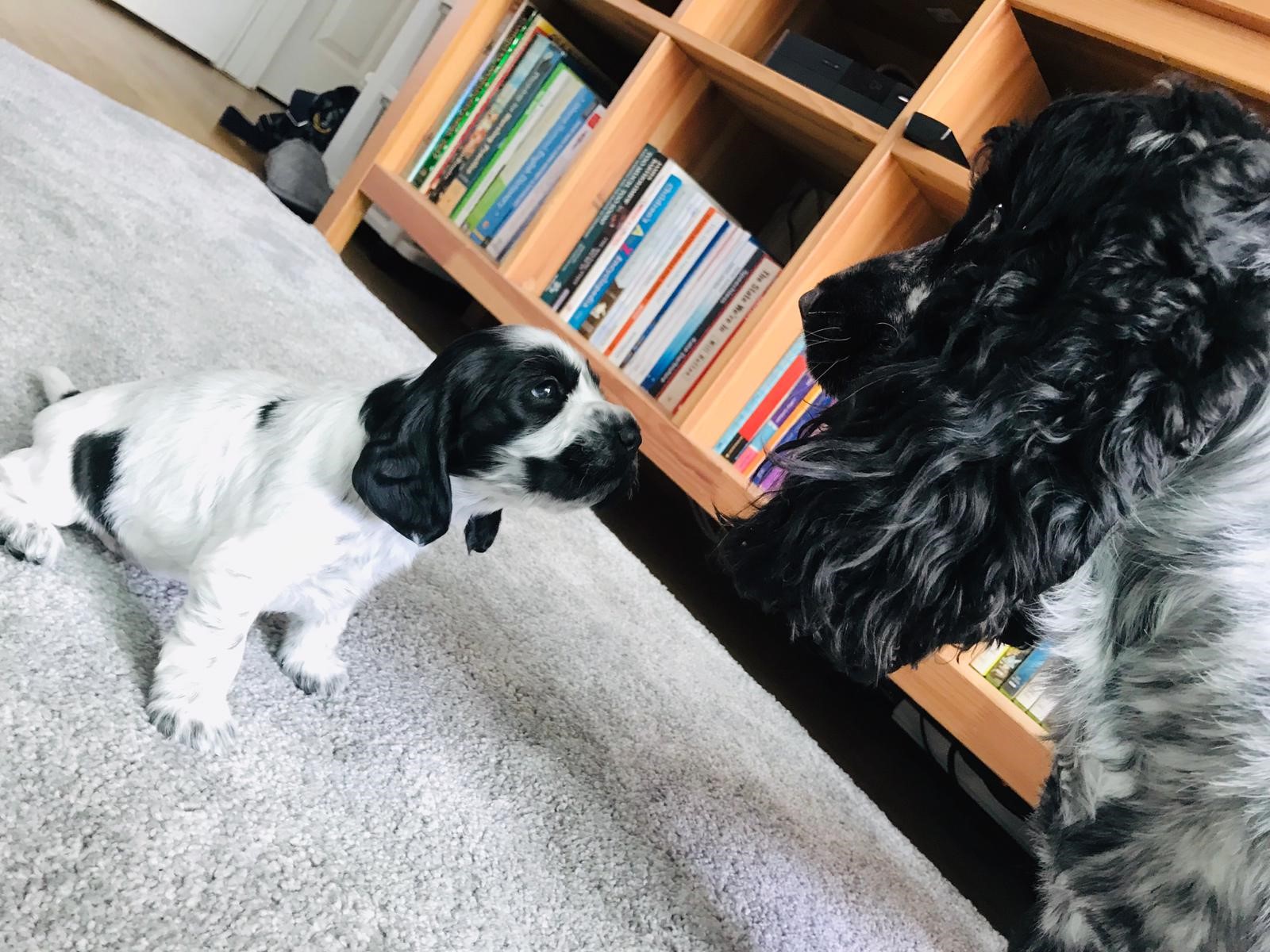
Pups will go through several stages of development, and to take them regularly to professional training classes, will ensure you are able to providing the right training input, at the right time, as they develop and mature.
I am deeply passionate about training and as such, integrate this into my Trinkaurity breeding programme. Potential puppy parents would be required to sign up to puppy training classes prior to collection of their Trinkaurity puppy. They would need to sign a contract stating they will commit to at least 12 months of weekly professional training classes.
Separation Anxiety: The English Cocker Spaniel
Separation Anxiety
Cockers can experience separation anxiety if they are not trained to self-settle. Therefore, it is critical that they learn to self-settle and have their own safe space, from tiny. Creating a safe, secure environment, where you puppy has a stable routine of exercise, mental stimulation, training, enrichment and toileting needs being met, will allow them to feel very secure. If you integrate leaving your puppy for very short periods of time from the very first day you bring them home, they will very quickly learn that when Mummy/Daddy leaves, they will be back.
I work with puppies from around 4/5 weeks of age, and crate train them all. By 8 weeks, all pups are able to settle into a crate on their own for a nap. When you bring your puppy home, or to any new environment, they will often take several steps backwards in their training as they associate behaviours to environments. You will need to associate their new crate as a place of security, safety and positivity where really good things happen.
